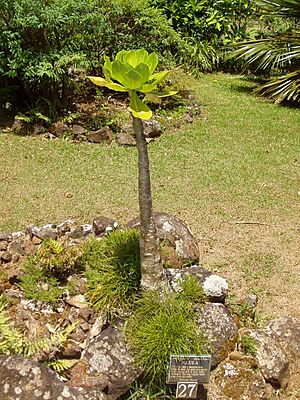Vulcan palm facts for kids
Quick facts for kids Vulcan palm |
|
|---|---|
 |
|
| Conservation status | |
| Scientific classification | |
| Genus: |
Brighamia
|
| Species: |
insignis
|
The vulcan palm or cabbage on a stick is a very rare plant. Its scientific name is Brighamia insignis. In Hawaiian, people call it ʻŌlulu or Alula. This plant belongs to the bellflower family. It is a special type of plant found only in Hawaii. You can find it on the islands of Kauaʻi and Niʻihau. It is an endangered species, meaning it is at risk of disappearing forever.
Contents
What the Vulcan Palm Looks Like
The Brighamia insignis plant has a thick, juicy stem. It is wide at the bottom and gets thinner towards the top. At the very top, it has a bunch of thick leaves that look like a rosette.
This stem is usually about 1 to 2 meters (3 to 6.5 feet) tall. But some plants can grow up to 5 meters (16 feet) tall! The plant blooms, or flowers, from September to November. Its flowers are yellow and smell sweet, like honeysuckle. They grow in groups of three to eight flowers. Each flower has petals joined together to form a tube. This tube is about 7 to 14 centimeters (3 to 5.5 inches) long. After flowering, the plant makes a capsule fruit. This fruit is about 13 to 19 millimeters (0.5 to 0.75 inches) long and holds many seeds.
Where the Vulcan Palm Lives
The Brighamia insignis is extremely rare. In 1994, experts found only about 45 to 65 plants in total. Because of this, the plant was listed as an endangered species. Today, it might even be gone from the wild. The last known wild plant was seen in 2014.
This plant grows from sea level up to 480 meters (1,575 feet) high. It likes places with less than 170 centimeters (67 inches) of rain each year. You can find it on rocky ledges and steep sea cliffs. These places have very little soil. Other plants that grow nearby include ʻāhinahina, ʻakoko, alaheʻe, and ʻilima.
Why the Vulcan Palm is Endangered
One big reason the Brighamia insignis is endangered is because its main pollinator is gone. A special type of hawk moth used to pollinate it. This moth helped the plant make seeds. But this moth is now extinct. This means the Brighamia insignis cannot make seeds on its own anymore. Humans now have to pollinate the plants by hand to help them reproduce.
Other things also threaten the plant. These include plants and animals brought from other places. For example, feral goats and pigs can harm the plants. Slugs, rats, and tiny spider mites also cause problems. Fire and strong hurricanes can damage the plants. Because the plant grows on steep cliffs, landslides are also a danger.
Growing the Vulcan Palm
Even though it is very rare in the wild, the Brighamia insignis is not hard to grow in a nursery. Because it is unique, some people grow it as a special ornamental plant in their gardens.
Gallery
See also
 In Spanish: Alula para niños
In Spanish: Alula para niños





